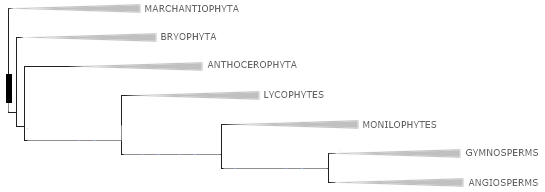H.-T. Li et al. (Nature Plants, 2019) - makes a great genetic analysis of data on the general structure of the classification of angiosperms, compares it with APG IV, although it brings only changes in the order sequence, without modifying them. Other classification in Angios Bergianska Website, by Jan Thomas Johansson, it is fantastic for the detailing, in plain text, of all the accepted genera in each family and its general distribution, sometimes even very detailed, and many easily accessible references.
Below we have the evolutionary trees of vascular plants as a whole, and then the evolutionary tree of angiosperms, focus of this blog, with 20 lineages at angiosperms: AMBORELLANAE, NYMPHAEANAE, AUSTROBAILEYANAE, CHLORANTHANAE, MAGNOLIANAE, LILIANAE, CERATOPHYLLANAE, RANUNCULANAE, PROTEANAE, TROCHODENDRANAE, BUXANAE, MYROTHAMNANAE, DILLENIANAE, SAXIFRAGANAE, VITANAE, ROSANAE, SANTALANAE, BERBERIDOPSIDANAE, CARYOPHYLLANAE and ASTERANAE.
Huipeng et al. (PRE-PRINT, 2023) suggests that the COM clade (Celastrales-Oxalidales-Malpighiales), currently considered part of Fabids, is actually independent of both Fabids and Malvids, being probably parallel to both.
 |
| ANGIOSPERM PHYLOGENY TREE, BI LI ET AL (BMC BIOLOGY, 2021) |
| GROUP | WORLD | SOUTH AMERICA | BRAZIL | EXXOFAMILIES | G/SPP IN SOUTH AMERICA |
| AMBORELLANAE NYMPHAEANAE AUSTROBAILEYANAE CHLORANTHANAE MAGNOLIANAE |
26 | 16 | 14 | ATHEROSPERMATACEAE GOMORTEGACEAE |
3/3 |
| LILIANAE |
80 | 51 | 44 | ZOSTERACEAE MELANTHIACEAE CORSIACEAE PHILESIACEAE ASTELIACEAE TECOPHILEACEAE RESTIONACEAE |
11/17 |
| CERATOPHYLLANAE RANUNCULANAE PROTEANAE TROCHODENDRANAE BUXANAE MYROTHAMNANAE |
16 | 11 | 8 | LARDIZABALACEAE PAPAVERACEAE NELUMBONACEAE |
5/8 |
| DILLENIANAE VITANAE SAXIFRAGANAE |
17 | 8 | 5 | GROSSULARIACEAE SAXIFRAGACEAE HAMAMELIDACEAE |
7/59 |
| ROSANAE/FABIDS |
75 | 58 | 51 | NOTHOFAGACEAE FAGACEAE MYRICACEAE JUGLANDACEAE BETULACEAE CORIARIACEAE BRUNELLIACEAE |
11/89 |
| ROSANAE/MALVIDS |
60 | 34 | 27 | ALZATEACEAE TAPISCIACEAE DIPENTODONTACEAE CYTINACEAE DIPTEROCARPACEAE KOEBERLINIACEAE TOVARIACEAE |
7/19 |
| SANTALANAE BERBERIDOPSIDANAE CARYOPHYLLANAE |
54 | 35 | 28 | MISODENDRACEAE AEXTOXICACEAE BERBERIDOPSIDACEAE FRANKENIACEAE HALOPHYTACEAE MONTIACEAE ANACAMPSEROTACEAE |
14/120 |
| ASTERANAE | 108 | 70 | 57 | POLEMONIACEAE ACTINIDIACEAE MITRASTEMONACEAE HYDRANGEACEAE CORNACEAE TETRACHONDRACEAE PELTANTHERACEAE PHRYMACEAE NAMACEAE HYDROPHYLLACEAE COLUMELIACEAE PHYLLONOMACEAE STYLIDIACEAE |
25/130 |
| 436 | 283 | 234 | 83/445 |
| COLOMBIA | 252 ✕ 234 | BRAZIL | ||
|
CL - BR = 28 (Fagaceae, Betulaceae, Juglandaceae, Myricaceae, Collumeliaceae, Dipentodontaceae, Tapisciaceae, Polemoniaceae, Montiaceae, Brunelliaceae, Actinidiaceae, Grossulariaceae, Dipterocarpaceae, Cytinaceae, Hydrangeaceae, Phyllonomaceae, Papaveraceae, Nelumbonaceae, Hamamelidaceae, Mitrastemonaceae, Alzateaceae, Phrymaceae, Peltantheraceae, Namaceae, Corna-ceae, Tovariaceae, Coriariaceae and Tetrachondraceae). BR - CL = 10 (Calyceraceae, Canellaceae, Quillajaceae, Nartherciaceae, Francoaceae, Cistaceae, Sarraceniaceae, Gelsemiaceae, Goodeniaceae and Griseliniaceae). |
||||
| VENEZUELA | 243 ✕ 234 | BRAZIL | ||
|
VZ - BR = 19: (Betulaceae, Juglandaceae, Myricaceae, Collumeliaceae, Dipentodontaceae, Tapisciaceae, Polemoniaceae, Montiaceae, Brunelliaceae, Actinidiaceae, Grossulariaceae, Papaveraceae, Melanthiaceae, Namaceae, Phrymaceae, Cornaceae, Tovariaceae, Coria-riaceae and Tetrachondraceae). BR - VZ = 10: (Calyceraceae, Lepidobotryceae, Francoaceae, Rhabdodendraceae, Strombosiaceae, Juncaginaceae, Griseliniaceae, Aniso-phylleaceae, Quillajaceae and Gelsemiaceae). |
||||
| PERU | 241 ✕ 234 | BRAZIL | ||
|
PR - BR = 24 (Tecophileaceae, Corsiaceae, Betulaceae, Juglandaceae, Myricaceae, Collumeliaceae, Dipentodontaceae, Tapisciaceae, Polemoniaceae, Montiaceae, Brunelliaceae, Actinidiaceae, Grossulariaceae, Hydrangeaceae, Phyllonomaceae, Papaveraceae, Saxifragaceae, Alzateaceae, Peltantheraceae, Namaceae, Hydrophyllaceae, Phrymaceae, Cornaceae, Tovariaceae, Coriariaceae and Frankeniaceae). BR - PR = 17 (Thurniaceae, Quillajaceae, Tetrameristaceae, Cannellaceae, Cyrillaceae, Nartherciaceae, Griseliniaceae, Rhabdodendraceae, Peridiscaceae, Sarraceniaceae, Cymodoceaceae, Surianaceae, Cistaceae, Ixonanthaceae, Gelsemiaceae, Goodeniaceae and Euphroniaceae). |
||||
| BOLIVIA | 236 ✕ 234 | BRAZIL | ||
|
BL - BR = 24 (Betulaceae, Juglandaceae, Myricaceae, Collumeliaceae, Dipentodontaceae, Polemoniaceae, Montiaceae, Brunelliaceae, Actinidiaceae, Grossulariaceae, Hydrangeaceae, Phyllonomaceae, Papaveraceae, Saxifragaceae, Koeberliniaceae, Alzateaceae, Phrymaceae, Peltantheraceae, Namaceae, Hydrophyllaceae, Cornaceae, Tovariaceae, Frankeniaceae and Anacampserotaceae). BR - BL = 22 (Cymodoceaceae, Thurniaceae, Taccaceae, Griseliniaceae, Lepidobotryceae, Nartherciaceae, Anisophylleaceae, Cannellaceae, Bonnetiaceae, Peridiscaceae, Euphroniaceae, Strombosiaceae, Sarraceniaceae, Quillajaceae, Goodeniaceae, Surianaceae, Cistaceae, Gelsemiaceae, Cyrillaceae, Rhabdodendraceae, Bataceae and Tetrameristaceae). |
||||
Martyniaceae, Anisophylleaceae, and Humiriaceae.
Achariaceae, Annonaceae, Balanophoraceae, Capparaceae, Cleomaceae, Commelinaceae, Connaraceae, Convolvulaceae, Eriocaulaceae, Iridaceae, Lauraceae, Ochnaceae, Ximeniaceae, Orobanchaceae, Linderniaceae, Lythraceae, Salicaceae, Polygalaceae, Menispermaceae, and Celastraceae.
28 famlies has endemic genera in a single country outher Brazil, mainly in Chile:
| 11 | CHILE | Aristolochiaceae, Campanulaceae, Caryophyllaceae, Escalloniaceae, Francoaceae, Lardizabalaceae, Gomortegaceae, Phillesiaceae, Plumbaginaceae, Phytolacaceae, Tecophileaceae. | ||||
| 5 | ARGENTINA | Anacampserotaceae, Montiaceae, Halophytaceae, Heliotropiaceae, Calyceraceae. | ||||
| 4 | PERU | Ranunculaceae, Costaceae, Muntingiaceae, Asparagaceae. | ||||
| 3 | GUYANA | Peridiscaceae, Passifloraceae, Erythropalaceae. | ||||
| 3 | COLOMBIA | Dipterocarpaceae, Vochysiaceae. | ||||
| 2 | VENEZUELA | Haemodoraceae, Xyridaceae. | ||||
| ZYGOPHYLLACEAE | 2 | 1 | 1 | ||||
| ERICACEAE | 2 | 1 | 2 | ||||
| BRASSICACEAE | 4 | 3 | 8 | ||||
| LOASACEAE | 2 | ||||||
| RAPATEACEAE | 2 | 4 | |||||
| VERBENACEAE | 2 | 1 | |||||
| 8 | 5 | 11 | 2 | 2 | 5 | 1 |
| GROUP | NUMBER | FAMILIES |
| AMBORELLANAE - MAGNOLIANAE | 1 | Chloranthaceae. |
| LILIANAE | 10 | Ruppiaceae, Juncaginaceae, Xanthorrhoeaceae, Nartherciaceae, Taccaceae, Haemodoraceae, Typhaceae, Mayacaceae, Thurniaceae and Strelitziaceae. |
| CERATOPHYLLANAE - MYROTHAMNANAE | 2 | Ceratophyllaceae and Buxaceae. |
| DILLENIANAE, SAXIFRAGANAE, VITANAE | 3 | Peridiscaceae, Crassulaceae and Haloragaceae. |
| ROSANAE | 12 | Zygophyllaceae, Quillajaceae, Surianaceae, Euphroniaceae, Goupiaceae, Ixonanhthaceae, Apodanthaceae, Lepidobotryaceae, Muntigiaceae, Cistaceae, Bataceae and Staphylleaceae. |
| SANTALANAE, BERBERIDOPSIDANAE, CARYOPHYLLANAE | 9 | Coulaceae, Basellaceae, Aizoaceae, Talinaceae, Phytolaccaceae, Plumbaginaceae, Achatocarpaceae, Cyrillaceae and Tetrameristaceae. |
| ASTERANAE | 7 | Hydroleaceae, Calceolariaceae, Stemonuraceae, Menyanthaceae, Goodeniaceae, Adoxaceae and Griseliniaceae. |
1 Distribution range separate, gene flow absent or very restricted between the infraspecific populations and differing in characters that are significant for taxonomic species differentiation within the genus ........................................subsp.
1 Distribution ranges overlapping, gene flow possible and not differing in characters that are significant for taxonomic species differentiation within the genus ........................................2.
2 Populations separate........................................var.
2 Mixed populations present........................................f.
Brazil has scarce diversity in many importante groups such as Brassicaceae, Caryophyllaceae, Amaranthaceae non Amaranthoideae.



